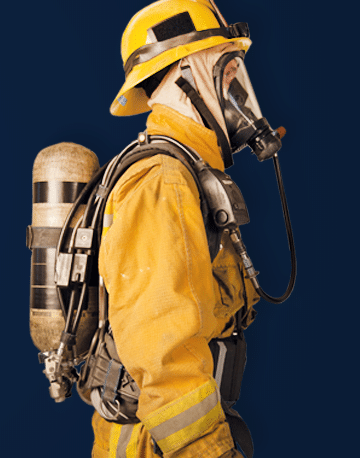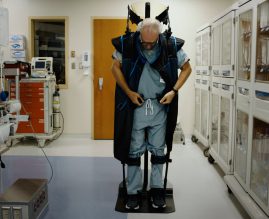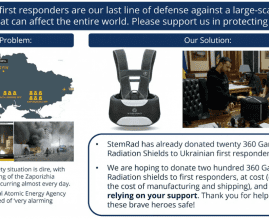Radiation – how to protect yourself during an event (and in the long run)
01.20.24 | Saturday | Nofit Amir
Radiation technology surrounds us in various forms, from medical imaging equipment to smoke detectors, shaping a world that relies on radiation. While the use of such technology is generally safe when equipped with proper safety measures, the potential for toxic radiation exists in numerous other scenarios.
The most perilous instances of radiation exposure often stem from the gradual leakage of radioactive materials, such as forgotten or submerged nuclear missiles, incidents involving nuclear reactors like the Fukushima earthquake in 2011, or residing in conflict-prone zones. It’s crucial to acknowledge that radiation, being invisible to the naked eye, demands a heightened awareness.
In such situations, the imperative is to ensure the adoption of appropriate measures for personal protection and safety, both in the immediate and long-term context. Whether facing the unseen threat of slow leaks or the aftermath of nuclear incidents, taking proactive steps becomes paramount for safeguarding oneself and promoting overall well-being.
How to protect yourself from radiation during the event?
In the event that you are faced with danger from gamma radiation or ionized particles in the air, the basic principles to remember for radiation protection are time, distance, and shielding. Airways are usually the first organs to get exposed. Gas masks, goggles, and gloves come in handy at times like this, even if it is not possible to access full-body protection.
Get to a place of safety immediately and discard everything that you’re wearing, followed by a shower to ensure that the exposure time is reduced. The shorter the time of exposure, the better protected you can be.
Distance yourself as much as possible from the radiation source. Depending on the size of the event, radiation exposure can happen for several miles around. Even when indoors, it is advisable to stay away from doors, windows, and even walls – stay close to the center of the space to maximize protection. Often, it may not be possible to distance yourself as much as you should from the source when you are within the containment zone. However, it is better to do as much as you can to reduce additional risks.
Radiation shielding is also important when taking shelter from radiation exposure. To minimize the effects of radiation, it is useful to have bunkers, basements, etc. that are lined with materials that prevent hazardous radioactive elements from seeping through. Remember that it is not safe to venture out unless deemed safe to do so by the experts and authorities in charge of the situation. Exposure zones typically require wearing radiation PPE, or any other radiation protection devices which can protect you to some extent from harm.
Long-term protection
In the long run, radiation protection depends on many factors. If ionized particles have been inhaled, suitable measures have to be taken to ensure that you do not develop thyroid cancer. Regular checks to detect radiation levels around you will be necessary. Radiation PPE is also of use when moving around affected areas, especially for civilians.
It is always better to be prepared for possible emergencies in the future. One way to do this is with radiation shielding. Lead is the gold standard when it comes to protection from radioactive elements in the long run. The density of the material prevents gamma rays from penetrating it.
All of this is possible with a reliable partner like StemRad, which offers patented solutions for protection from radiation. Since radioactive resources are unavoidable in order for certain equipment and industries to function, the prudent approach is to have cutting-edge technology and the knowledge to protect human lives from potentially hazardous radiation. It is not just first response personnel and medical staff who require protection, but also every individual within the potential radiation zone that needs to take adequate precautions.
Civilians are unlikely to ever have control over a radiation event. This is why there are protocols in place that are to be followed in the likelihood that any major or minor events occur. StemRad protects personnel with its technologically advanced shielding that allows for ergonomic movement while also ensuring the safety of vulnerable parts of the body.
While StemRad takes care of your safety needs from radiation, your role is to stay away from the event and keep your family safe. Be prepared for such circumstances by ensuring that you and your loved ones are adequately protected from potentially harmful radiation.
Ensuring Survival in Nuclear Disasters: StemRad’s Selective Shielding Technology Redefines Mobility
As the world edges closer to potential nuclear or radiological disasters, preparation becomes paramount. With the Bulletin of the Atomic Scientists signaling an alarming two minutes to midnight, the United States must ready itself for potential thermonuclear war, rogue regime detonations, terrorist radiological attacks, or nuclear reactor accidents. In the aftermath of such incidents, access to essential supplies like food, water, and sanitation kits will be scarce until civil services can be restored.
Mobility emerges as a critical element for successful survival, yet the surrounding environment may be contaminated with lethal levels of radioactivity. Traditional protective gear, like HAZMAT suits and respiration masks, falls short in shielding against penetrating gamma radiation. StemRad addresses this gap with its revolutionary 360 Gamma technology, selectively shielding the body’s most radiation-vulnerable tissues.
StemRad’s technology, proven effective in collaboration with the US Department of Energy and previously with NASA and Lockheed Martin for astronauts, allows individuals to be mobile within radioactive environments. By lightening the load and preventing radiation sickness, StemRad’s selective shielding offers a lifeline in the face of potential nuclear disasters. Survivors equipped with this breakthrough technology gain the ability to reach safe shelter, resupply, and transport to safer locations, reshaping the human survivability quotient after exposure to radiation.
Surviving Nuclear Disasters: StemRad’s 360 Gamma Civilian Version – A Compact Lifesaver in a Duffle Bag
Amid the looming threat of nuclear disasters, preparing for survival becomes a critical endeavor, and StemRad’s 360 Gamma Civilian Version offers a compact solution that fits into a duffle bag. Radiation exposure during such incidents comes in the form of fallout (radioactive particles) and penetrating waves. To shield against airborne particles, essential items like respiration masks, iodine pills, gloves, goggles, and full-body clothing are necessary. However, protecting against penetrating waves requires a radiation shield, uniquely designed for the hip region, the most vulnerable tissue in the body.
StemRad’s radiation protection shield represents a breakthrough in survivability after radiation exposure, preventing sickness and reducing cancer risks. While ideal preparedness involves a specially made bunker, the reality is that even those with bunkers need a safe means of mobility. StemRad’s radiation shield facilitates this, allowing survivors to move safely, search for shelter, or gather loved ones during a nuclear catastrophe.
Incorporating guidance from a U.S. federal report on nuclear disaster preparedness, StemRad’s radiation shield becomes a critical component for survivors, enabling them to withstand penetrating radiation and execute necessary tasks. As studies confirm its high effectiveness, StemRad’s radiation shielding emerges as a potential lifesaver for those exposed to radiation in the unfortunate event of a nuclear disaster.
Frequently Asked Questions
What materials can block radiation?
Any material can block radiation, as long as there is enough mass of it. However, some materials are more efficient than others at blocking radiation. High-density and high atomic number elements such as lead and tungsten are very effective against neutral radiation such as gamma, X-ray, and neutron radiation, while hydrogenous materials such as water and hydrocarbons are very effective against charged particles such as protons and alpha particles.
What is the easiest way to be safe from radiation?
The two easiest ways to protect oneself from radiation are to keep one's time of exposure to a minimum and to maintain the maximum possible distance from the source.
How can you protect yourself from radiation exposure?
If in a situation where radiation exposure is unavoidable, shielding can be used to protect oneself from radiation. Examples of sheilding can be concrete bunkers, leaded glass or acrylic barriers, or personal protective shielding, such as StemRad's family of products.
I want to buy a whole body radiation suit for gamma radiation. Where can I find one?
There is no such thing as a whole body radiation suit. Such a suit would be extremely massive and cumbersome. There are diminishing returns in shielding the entire body, since most radiation-sensitivie organs and tissues are located in the head, neck, and torso regions. Selective shielding has been proven to be very effective at reducing the overall risks of acute radiation syndrome and cancer.

Writes content for StemRad’s website, social media, and newsletter. She is an advocate with over twenty years of experience of writing high-end content in academic and industrial settings.



